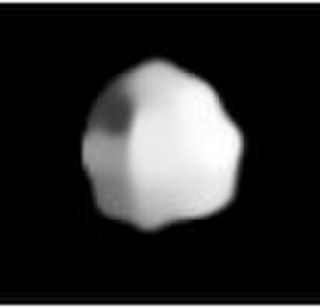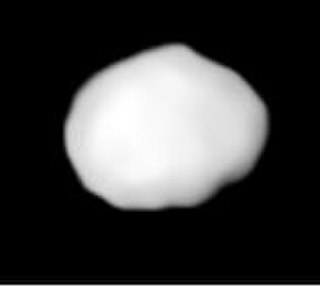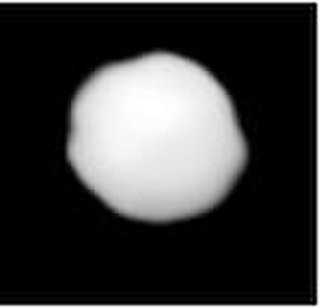Related Research Articles
4486 Mithra, is an eccentric asteroid and suspected contact-binary, classified as near-Earth object and potentially hazardous asteroid, approximately 2 kilometers in diameter. It belongs to the Apollo group of asteroids and is a relatively slow rotator.

Melpomene is a large, bright main-belt asteroid that was discovered by J. R. Hind on 24 June 1852, and named after Melpomenē, the Muse of tragedy in Greek mythology. It is classified as an S-type asteroid and is composed of silicates and metals. This asteroid is orbiting the Sun at a distance of 2.296 AU with a period of 3.48 years and an eccentricity (ovalness) of 0.22. The orbital plane is tilted at an angle of 10.1° to the plane of the ecliptic.

Leda is a large, dark main-belt asteroid that was discovered by French astronomer J. Chacornac on January 12, 1856, and named after Leda, the mother of Helen of Troy in Greek mythology. In the Tholen classification system, it is categorized as a carbonaceous C-type asteroid, while the Bus asteroid taxonomy system lists it as a Cgh asteroid. The spectra of the asteroid displays evidence of aqueous alteration.

Thisbe, minor planet designation 88 Thisbe, is the 13th largest main-belt asteroid. It was discovered by C. H. F. Peters on June 15, 1866, and named after Thisbe, heroine of a Roman fable. This asteroid is orbiting the Sun at a distance of 2.768 AU with a period of 4.60 years and an orbital eccentricity (ovalness) of 0.165. The orbital plane is inclined at an angle of 5.219° to the ecliptic.
Helena is a large, rocky main-belt asteroid. It was discovered by Canadian-American astronomer J. C. Watson on August 15, 1868, and was named after Helen of Troy in Greek mythology.

Felicitas is a dark and fairly large main-belt asteroid. It was discovered by German-American astronomer C. H. F. Peters on October 9, 1869, and named after Felicitas, the Roman goddess of success. The only observed stellar occultation by Felicitas is one from Japan.

Kassandra is a large and dark main-belt asteroid. It belongs to the rare class T. It was discovered by C. H. F. Peters on July 23, 1871, and is named after Cassandra, the prophetess in the tales of the Trojan War. The asteroid is featured in the 2009 film Meteor, in which it is split in two by a comet, and set on a collision course with Earth.

Adeona is a large asteroid from the intermediate asteroid belt, approximately 150 kilometers in diameter. Its surface is very dark, and, based upon its classification as a C-type asteroid, is probably composed of primitive carbonaceous material. The spectra of the asteroid displays evidence of aqueous alteration. The Adeona family of asteroids is named after it.
Isolda is a very large, dark main-belt asteroid. It is classified as a C-type asteroid and is probably composed of primitive carbonaceous material. The spectra of the asteroid displays evidence of aqueous alteration.
225 Henrietta is a very large outer main-belt asteroid. It was discovered by Austrian astronomer Johann Palisa on April 19, 1882, in Vienna and named after Henrietta, wife of astronomer Pierre J. C. Janssen. The asteroid is orbiting at a distance of 3.39 AU from the Sun with a period of 6.24 years and an eccentricity (ovalness) of 0.26. The orbital plane is inclined at an angle of 20.9° to the plane of the ecliptic. 225 Henrietta belongs to Cybele group of asteroids and is probably in a 4:7 orbital resonance with the planet Jupiter.

Eukrate is a rather large main-belt asteroid. It is dark and probably a primitive carbonaceous body. The asteroid was discovered by Robert Luther on March 14, 1885, in Düsseldorf. It was named after Eucrate, a Nereid in Greek mythology.

Aline is a fairly large main belt asteroid that was discovered by Johann Palisa on 17 May 1887 in Vienna and is thought to have been named after the daughter of astronomer Edmund Weiss. It is a dark C-type asteroid and is probably composed of primitive carbonaceous material. 266 Aline is orbiting close to a 5:2 mean motion resonance with Jupiter, which is located at 2.824 AU.
Anahita is a stony S-type Main belt asteroid. It was discovered by C. H. F. Peters on October 8, 1887, in Clinton, New York, and was named after the Avestan divinity Aredvi Sura Anahita.
Chaldaea is a large Main belt asteroid. It is classified as a C-type asteroid and is probably composed of carbonaceous material. It was discovered by Johann Palisa on 30 August 1891 in Vienna.

Lacadiera is a large Main belt asteroid. It is classified as a D-type asteroid and is probably composed of organic rich silicates, carbon and anhydrous silicates. The asteroid was discovered by Auguste Charlois on 19 September 1892 in Nice.
Lampetia is a fairly large main belt asteroid that was discovered by German astronomer Max Wolf on 4 November 1894 in Heidelberg. It has an unusually low rotation rate, with a period estimated at 38.7 hours and a brightness variation of 0.14 in magnitude.
Lotis is a large Main belt asteroid. It is classified as a probable C-type asteroid and is likely composed of primitive carbonaceous materials. This object was discovered by Auguste Charlois on 23 November 1897 in Nice.
Kreusa is a C-type asteroid orbiting the Sun in the asteroid belt, with the type indicating a surface with a low albedo and high carbonaceous content. The spectra of the asteroid displays evidence of aqueous alteration.

Cava is a minor planet orbiting the Sun.
622 Esther is a minor planet orbiting the Sun.
References
- ↑ Noah Webster (1884) A Practical Dictionary of the English Language
- 1 2 3 4 5 6 7 "JPL SBDB: 405 Thia (1895 BZ)". JPL Small-Body Database . NASA/Jet Propulsion Laboratory. Archived from the original on 31 July 2012. Retrieved 20 February 2023.
- 1 2 3 Carry, B. (December 2012), "Density of asteroids", Planetary and Space Science, vol. 73, pp. 98–118, arXiv: 1203.4336 , Bibcode:2012P&SS...73...98C, doi:10.1016/j.pss.2012.03.009. See Table 1.
- ↑ Schmadel, Lutz D. (2003). Dictionary of Minor Planet Names. Berlin, Heidelberg, New York: Springer. p. 48. ISBN 3-540-00238-3. Archived from the original on 14 March 2014.
- ↑ Magri, Christopher; et al. (January 2007), "A radar survey of main-belt asteroids: Arecibo observations of 55 objects during 1999 2003" (PDF), Icarus, 186 (1): 126–151, Bibcode:2007Icar..186..126M, doi:10.1016/j.icarus.2006.08.018 , retrieved 14 April 2015.
- ↑ "Horizons Batch for Thia in May 1990". JPL Horizons . Retrieved 20 February 2023.